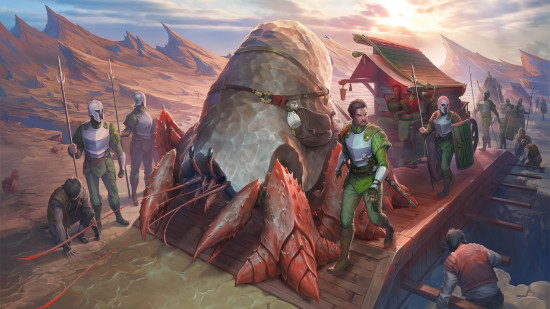Not every tabletop RPG fan has read Brandon Sanderson’s Stormlight Archive novels, but most know their way around a d20. It makes sense, then, that the Stormlight RPG takes a lot of inspiration from existing RPG giants like D&D and Pathfinder. It also makes sense that the Stormlight RPG tries a few new tricks to stand out – though sadly for me, these don’t feel too successful.
Like a coming storm, this opinion began brewing while I read through the game’s beta rules, kindly provided by publisher Brotherwise Games. This early version of the rules, as well as a starter adventure, will be available when the Stormlight RPG Kickstarter goes live on August 6.
Because of the incomplete nature of these rules (and the fact I’m basing my thoughts on a readthrough rather than a playthrough), these are naturally ‘first impression’ opinions. Basically, take what I say with a slight pinch of salt.
The ‘first’ of these first impressions is how much the Stormlight RPG mirrors the two major d20 tabletop RPGs. Like Pathfinder, the Stormlight RPG lets you take up to three actions in a turn, and it measures degrees of success and failure when you make a roll. Many of D&D’s tried-and-tested features reappear here also – difficulty classes, fall damage, and resting all feel familiar.
There are no DnD classes to speak of, but the ‘paths’ you pick and progress fit naturally with the d20 system nonetheless. The rules for ‘endeavours’, encounters that fall somewhere between combat and conversation, even echo the skill challenges found in D&D 4e.
The major way that the Stormlight RPG strays from the path is narrative. One of its flagship features is the ‘plot die’, a d6 that can be added to a regular roll to raise the stakes. This doesn’t modify your d20 roll, but it can add opportunities or complications to the way your roll is resolved. Rolling a natural one or a natural 20 can also introduce opportunities and complications (meaning you can have several of these cropping up at once).
Mechanically, opportunities can grant a player advantage (something that can also be applied multiple times, and can be used on dice other than the d20), resources, critical hits, or positive narrative outcomes. Complications have the opposite effect, doling out disadvantages and unhelpful events. Oh, and speaking of events, opportunities and complications can be used to further larger events, both good and ill.
The Stormlight RPG has differentiated itself by quantifying the storytelling side of tabletop RPGs. These mechanics aim to create a complex narrative web rather than a linear ‘A to B’ kind of game. Where Pathfinder crunches character builds, the Stormlight RPG wants to crunch stories – and this is my biggest issue with the system.
When I’m not writing about D&D or the best board games of recent days, I write poetry. It’s a creative, free-form process, where too much planning can actually be counterproductive. I write my best poems when I start with a vague concept and let my subconscious fill in the blanks as I add words to the page. When I try to write a poem with a clear meaning, beginning, and end, the result is an over-engineered poem.
In a similar way, the Stormlight RPG risks over-engineering its stories. Game Masters will need to plan multiple possible opportunities and consequences for every encounter, as they can modify any roll (often more than once). Similarly, every instance of advantage or disadvantage feels like it needs narrative justification.
For some people, these tools might inspire new ways to develop their campaigns. But for me, I’m fairly confident I’ll get bogged down by the mechanics. Natural improvisation and nuanced story beats that can’t be defined by rules jargon will take a back seat. In their place will be the kind of storytelling that can only exist in spreadsheets.
The Stormlight RPG stands out in ways beyond these mechanics, with mixed success. Its Initiative-free take on combat is fast, flexible, and fun in a way that echoes (but doesn’t directly mirror) the recent Daggerheart RPG. Its stats create an interesting list of ‘defenses’ which feel more nuanced than a simple HP system, and the designers have made a clear effort to consider disabled characters when deciding how character options function.
However, its skills and damage types feel almost deliberately obscure. Unintuitive naming conventions feel like they were designed purely to differentiate themselves from other d20 games, and they’ll add to the barrier to entry new players face when learning the system.
My overall first impression is that the Stormlight RPG has plenty of potential for fun, but it’s more fiddly than it needs to be. Especially when it comes to telling stories – unless the complete rules can win me over, it looks like I’ll be getting my creative kicks elsewhere.
For more recent RPG updates, check out what we know so far about One DnD. Or, for rules you can use right now, here’s everything you need to know about DnD races.
Source: Wargamer




